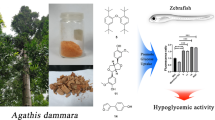Abstract
Senegasaponins [senegin II (1), senegin III (2), senegin IV (3), senegasaponin a (4), and senegasaponin b (5)] from Polygala senega were re-discovered as selective anti-proliferative substances against human umbilical vein endothelial cells (HUVECs). Senegasaponins (1–5) showed anti-proliferative activity against HUVECs with IC50 values in the range 0.6–6.2 μM, and the selective index was 7–100-fold in comparison with those for several cancer cell lines, while the desacyl mixture of senegasaponins (6) and tenuifolin (7) lost anti-proliferative activity, indicating that the 28-O-glycoside moiety and methoxycinnamoyl group were essential for the HUVEC-selective growth inhibition of senegasaponins. Senegin III (2) inhibited the vascular endothelial growth factor (VEGF)-induced in vitro tubular formation of HUVECs and basic fibroblast growth factor (bFGF)-induced in vivo neovascularization in the mouse Matrigel plug assay. Moreover, senegin III (2) suppressed tumor growth in the ddY mice s.c.-inoculated murine sarcoma S180 cells. The analysis of the action mechanism of senegin III (2) suggested that the induction of pigment epithelium-derived factor (PEDF) would contribute to the anti-angiogenic effects of senegasaponins.







Similar content being viewed by others
References
Folkman J (1995) Angiogenesis in cancer, vascular, rheumatoid and other disease. Nat Med 1:27–31
Folkman J (1990) What is the evidence that tumors are angiogenesis dependent? J Natl Cancer Inst 82:4–6
Fan TP, Jaggar R, Bicknell R (1995) Controlling the vasculature: angiogenesis, anti-angiogenesis and vascular targeting of gene therapy. Trends Pharmacol Sci 16:57–66
Aoki S, Cho SH, Ono M, Kuwano T, Nakao S, Kuwano M, Nakagawa S, Gao JQ, Mayumi T, Shibuya M, Kobayashi M (2006) Bastadin 6, a spongean brominated tyrosine derivative, inhibits tumor angiogenesis by inducing selective apoptosis to endothelial cells. Anticancer Drugs 17:269–278
Aoki S, Sanagawa M, Watanabe Y, Setiawan A, Arai M, Kobayashi M (2007) Novel isomarabarican triterpenes, exhibiting selective anti-proliferative activity against vascular endothelial cells, from marine sponge Rhabdastrella globostellata. Bioorg Med Chem 15:4818–4828
Aoki S, Watanabe Y, Sanagawa M, Setiawan A, Kotoku N, Kobayashi M (2006) Cortistatins A, B, C, and D, anti-angiogenic steroidal alkaloids, from the marine sponge Corticium simplex. J Am Chem Soc 128:3148–3149
Yoshikawa M, Murakami T, Ueno T, Kadoya M, Matsuda H, Yamahara J, Murakami N (1995) E-senegasaponins A and B, Z-senegasaponins A and B, Z-senegins II and III, new type inhibitors of ethanol absorption in rats from senegae radix, the roots of Polygala senega L. var latifolia Torrey et Gray. Chem Pharm Bull 43:350–352
Yoshikawa M, Murakami T, Ueno T, Kadoya M, Matsuda H, Yamahara J, Murakami N (1995) Bioactive saponins and glycosides. I. Senegae radix. (1): E-senegasaponins a and b and Z-senegasaponins a and b, their inhibitory effect on alcohol absorption and hypoglycemic activity. Chem Pharm Bull 43:2115–2122
Yoshikawa M, Murakami T, Matsuda H, Ueno T, Kadoya M, Yamahara J, Murakami N (1996) Bioactive saponins and glycosides. II. Senegae Radix. (2): Chemical structures, hypoglycemic activity, and ethanol absorption-inhibitory effect of E-senegasaponin c, Z-senegasaponin c, and Z-senegins II, III, and IV. Chem Pharm Bull 44:1305–1313
Estrada A, Katselis GS, Laarveld B, Barl B (2000) Isolation and evaluation of immunological adjuvant activities of saponins from Polygala senega L. Comp Immunol Microbiol Infect Dis 23:27–43
Sakuma S, Shoji J (1981) Studies on the constituents of the root of Polygala tenuifolia Willdenow. II. On the structures of onjisaponins A, B and E. Chem Pharm Bull 30:810–821
Desbène S, Hanquet B, Shoyama Y, Wagner H, Lacaille-Dubois MA (1999) Biologically active triterpene saponins from callus tissue of Polygala amarella. J Nat Prod 62:923–926
Lin KT, Lien JC, Chung CH, Kuo SC, Huang TF (2010) A novel compound, NP-184, inhibits the vascular endothelial growth factor induced angiogenesis. Eur J Pharmacol 630:53–60
Drabkin DL, Austin JH (1935) Spectrophotometric studies: II. Preparations from washed blood cells; nitric oxide hemoglobin and sulfhemoglobin. J Biol Chem 112:51–65
Hood JD, Frausto R, Kiosses WB, Schwartz MA, Cheresh DA (2003) Differential alphav integrin-mediated Ras-ERK signaling during two pathways of angiogenesis. J Cell Biol 162:933–943
Gerber HP, McMurtrey A, Kowalski J, Yan M, Keyt BA, Dixit V, Ferrara N (1998) Vascular endothelial growth factor regulates endothelial cell survival through the phosphatidylinositol 3′-kinase/Akt signal transduction pathway. Requirement for Flk-1/KDR activation. J Biol Chem 273:30336–30343
Ek ETH, Dass CR, Choong PFM (2006) PEDF: a potential molecular therapeutic target with multiple anti-cancer activities. Trends Mol Med 12:497–502
Sengupta S, Toh SA, Sellers LA, Skepper JN, Koolwijk P, Leung HW, Yeung HW, Wong RN, Sasisekharan R, Fan TP (2004) Modulating angiogenesis: the yin and the yang in ginseng. Circulation 110:1219–1225
Leung KW, Cheung LWT, Pon YL, Wong RNS, Mak NK, Fan TP, Au SCL, Tombran-Tink J, Wong AST (2007) Ginsenoside Rb1 inhibits tube-like structure formation of endothelial cells by regulating pigment epithelium-derived factor through the oestrogen beta receptor. Br J Pharmacol 152:207–215
Acknowledgments
The authors thank Koshiro Company Ltd. for kindly providing the Polygala senega. The authors are grateful to the Hoh-ansha Foundation and the Uehara Memorial Foundation for the financial support. This study was also financially supported by a Grant-in-Aid for Scientific Research from the Ministry of Education, Culture, Sports, Science and Technology of Japan (MEXT).
Author information
Authors and Affiliations
Corresponding author
Additional information
M. Arai and A. Hayashi contributed equally to this work.
Rights and permissions
About this article
Cite this article
Arai, M., Hayashi, A., Sobou, M. et al. Anti-angiogenic effect of triterpenoidal saponins from Polygala senega . J Nat Med 65, 149–156 (2011). https://doi.org/10.1007/s11418-010-0477-7
Received:
Accepted:
Published:
Issue Date:
DOI: https://doi.org/10.1007/s11418-010-0477-7




